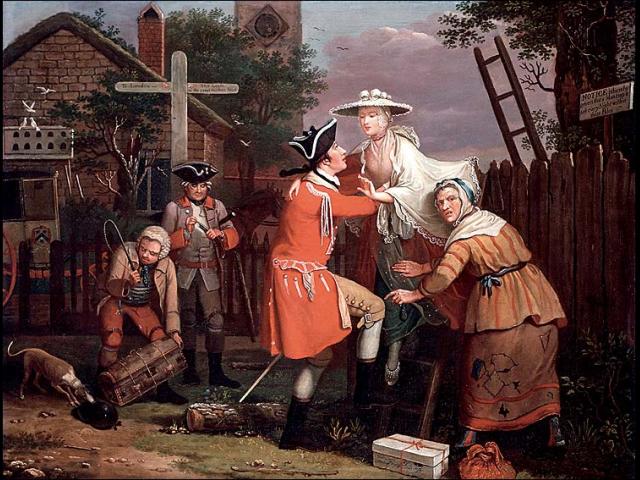Two 18th-century Elopements in the Beverley area
In Jane Austen’s Pride and Prejudice 16-year-old Lydia Bennet writes the following note to the woman who had been acting as her chaperone: ‘You will laugh when you know where I am gone, and I cannot help laughing myself at your surprise tomorrow morning, as soon as I am missed. I am going to Gretna Green, and if you cannot guess with who, I shall think you a simpleton.’
Lydia’s plan to elope to Scotland with Wickham failed to materialise, but many other couples did make the journey to Gretna Green during the Georgian period. Following the Marriage Act of 1754 marriages in England had to take place in a church, and a couple could not marry without the consent of their parents if they were under the age of 21. Under Scottish law all that was required was for the parties to undergo a ‘marriage of declaration’ or a ‘handfasting ceremony’. As Gretna was the first place over the border that runaways reached on the main route from London to Scotland, this became the traditional place for clandestine marriages. Many of these involved young girls from well-off families.
On 10 March 1792 John Courtney of Newbegin House in Beverley noted in his diary: ‘This morning we heard that Miss Gee went off yesterday from Mr Barnard's at [South] Cave with her cousin Mr Hotham in a post chaise and four for Gretna Green and afterwards we found they were married there this day. Miss Gee went out at Cave to take a walk, and Captain Hotham brought a chaise from Halfway House and met her and away they went. She was certainly one of the prettiest girls in this country and extremely well behaved and agreeable.' A search through parish registers shows that on 12 April George Hotham and Caroline Gee, who was only 17, underwent a ‘proper’ marriage ceremony at St Mary Lowgate in Hull. Both were described as of that parish although this was not the case.
On 5 April the same year, less than a month after reporting the above elopement, Courtney wrote: ‘This morning I heard that Mr Beverley and Miss Midgley went off last night in a chaise and four for Gretna Green. They went out of the dining room window and walked down Pickhill Lane in the rain and got into the chaise in Westwood. ... This trip has soon followed that of Captain Hotham and Miss Gee. The great fortunes at Beverley have all married in a hurry lately.’
Mary Midgley was the daughter of Jonathan Midgley, attorney, builder of Norwood House, and it was through the dining room window of that house that the couple made their escape. ‘Pickhill’ or Pighill Lane is now called Manor Road. Mary Midgley had been baptised at St Mary’s church in Beverley in November 1775 so, like Lydia Bennet, must have been only 16 when she eloped with William Beverley. On their return to the town they were accepted as a married couple. On 30 April Courtney records that he was at the theatre. ‘I sat behind Mr and Mrs Beverley the bride and bridegroom whom I had not seen since they were married; I wish'd them joy ...they gave out Gretna Green [the name of a play] as the farce for next Wednesday [at the theatre]. I laughed at Beverley and asked him if he had bespoke it.’ On 1 May the couple married again, this time at St Mary’s church in Beverley.
Susan Neave 2020



